2. 矿床地球化学国家重点实验室, 中国科学院地球化学研究所, 贵阳 550002
2. State Key Laboratory of Ore Deposit Geochemistry, Institute of Geochemistry, Chinese Academy of Sciences, Guiyang 550002, China
对煌斑岩进行研究,有助于揭示岩石圈地幔富集作用、壳-幔相互作用、以及地球各圈层物质循环等深部地质作用过程,故近年来煌斑岩受到越来越多学者的关注(Bergman,1987; Foley et al.,1987; 路凤香等,1991; Guo et al.,2004; Owen,2008; Mahéo et al.,2009; Niu et al.,2011; Ma et al.,2014a; 和文言等,2014)。钙碱性煌斑岩由于常分布于金矿和锑矿矿区,可能与金、锑矿化有关,而备受岩石学家和矿床学家的重视(Rock,1987; Rock and Groves,1988a,b; Rock et al.,1991; Ashley et al.,1994; Taylor et al.,1994; 黄智龙等,1996,1999; 张勇等,2003; Guo et al.,2004; Karsli et al.,2014; Ma et al.,2014a,b)。关于煌斑岩与金矿的关系,目前主要有两种观点:(1)煌斑岩与金矿存在成因联系,很多学者认为产出于碰撞后造山环境中的钙碱性煌斑岩,为金成矿提供了成矿物质和驱动能量,煌斑岩与金矿有着密切的时、空联系(McNeil and Kerrich,1986; Rock,1987; Rock and Groves,1988a,b; Rock et al.,1991; Müller and Grones,1993);(2)煌斑岩并未提供成矿物质,煌斑岩与金矿只是受相同构造的控制,两者之间没有任何成因联系(Wyman and Kerrich,1988,1989; Ashley et al.,1994; Taylor et al.,1994; 李献华和孙贤鉥,1995; 翟建平等,1996; Huang et al.,1999)。目前人们对与金矿有关的煌斑岩研究较多,但对分布于锑矿区的煌斑岩关注较少。
湘中是华南岩石圈最厚的地区(饶家荣等,1993; 袁学诚和华九如,2011),也是我国锑矿分布最为密集的地区;尽管人们对该区深部地质已开展了一些研究(饶家荣等,1993,1999),但该区岩石圈增厚的机制、地幔性质以及深部地质过程,目前仍不太清楚。湘中锡矿山锑矿区,发育有一条长约10km的煌斑岩脉,该脉岩形成于中生代,是整个锡矿山地区唯一的岩浆活动记录;该煌斑岩为了解湘中地区中生代地幔源区性质及深部地质过程提供了窗口。尽管前人对其进行了一些地球化学研究(吴良士和胡雄伟,2000; 谢桂青等,2001; 易建斌等,2001; 彭建堂等,2014),但该煌斑岩的成因、源区性质以及与锑成矿的关系,目前仍不太清楚。因此,本文拟在前人工作的基础上,对锡矿山煌斑岩进行详细的野外地质调研和岩相学研究,并对该煌斑岩的主量元素、微量元素、Sr-Nd同位素进行测试分析,试图解决上述地质问题,并初步揭示湘中地区中生代地幔属性及其深部地质过程。
2 地质特征锡矿山锑矿床位于湘中盆地(图 1),是世界上最大的锑矿床,素有“世界锑都”的美称。矿区主要出露的地层为上泥盆统和下石炭统(图 2),岩性主要以碳酸盐岩为主,夹少量页岩、粉砂岩及泥质岩。矿体主要赋存于上泥盆统佘田桥组(D3s)硅化灰岩中,少量产于矿区深部的棋梓桥组(D2q)弱硅化灰岩中(刘光模和简厚明,1983; 刘焕品等,1985)。矿区东部出露的煌斑岩(图 2)是该区唯一的岩浆活动显示。已有的勘探资料表明,锡矿山矿区的锑矿化均分布于西部的F75断裂与东部的煌斑岩脉之间(刘光模和简厚明,1983; 刘焕品等,1985)。

|
图 1 湘中锡矿山地区的大地构造位置图(据史明魁等,1994; Li and Li,2007修改) Fig. 1 Tectonic location of the Xikuangshan district,central Hunan(after Shi et al.,1994; Li and Li,2007) |
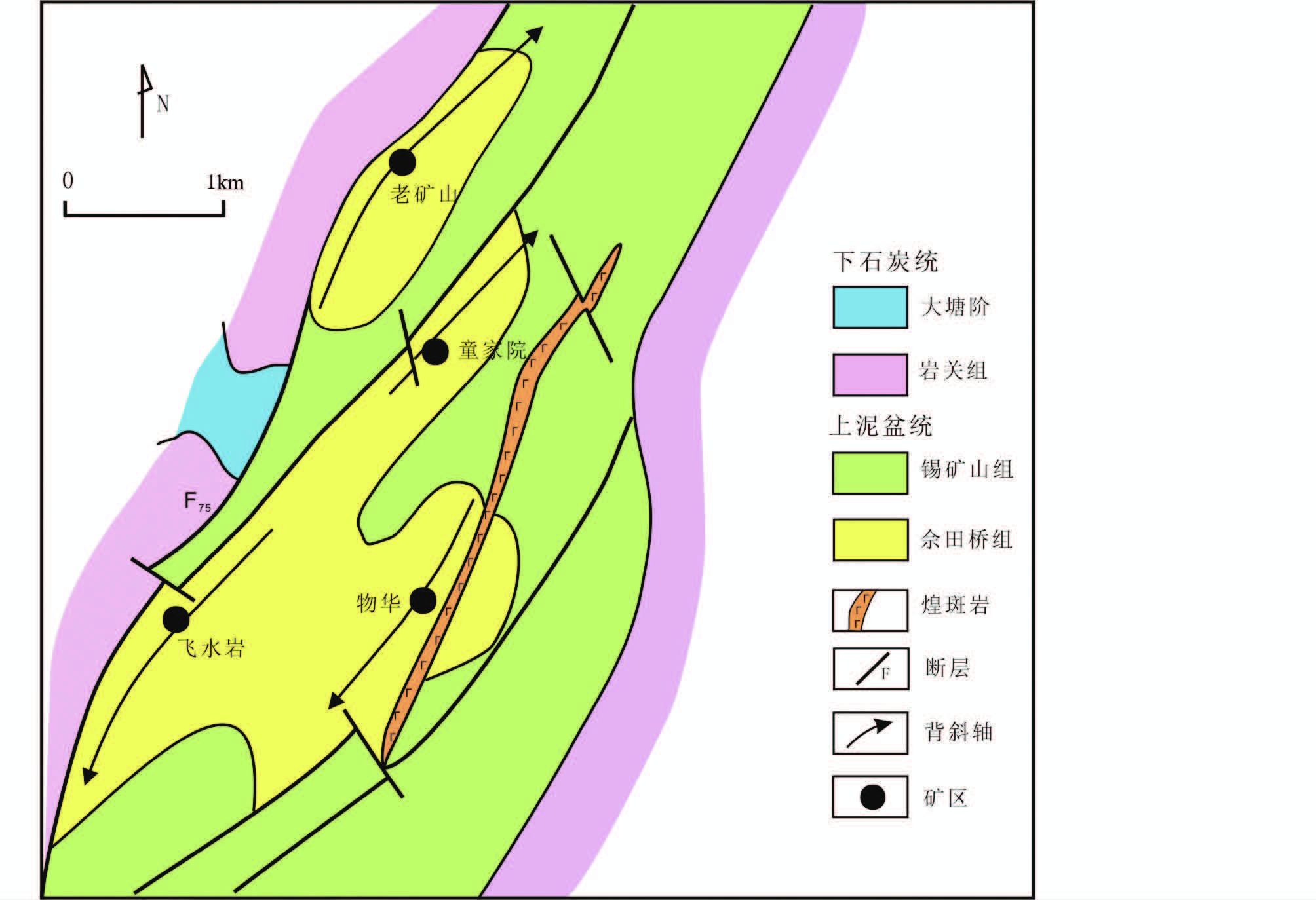
|
图 2 湘中锡矿山锑矿床地质图(据金景福等,1999修改) Fig. 2 Geological map of the Xikuangshan antimony deposit,central Hunan(after Jin et al.,1999) |
锡矿山煌斑岩呈脉状产出,受NE向断裂控制,侵位于上泥盆统佘田桥组和锡矿山组中,与围岩呈明显的侵入接触关系。该煌斑岩沿NE10°~25°方向延伸10km以上,倾向SE,倾角近于直立;岩脉宽度变化较大,最宽处可达10m左右,最窄仅0.2m,一般为2~4m,煌斑岩露头在灰岩中较宽,而在页岩中往往较窄(吴良士和胡雄伟,2000)。前人已有的钻探资料表明,该煌斑岩在深部存在分枝现象(湖南省地质研究所,1983①)(①湖南省地质研究所. 1983. 湖南省锡矿山锑矿田地质特征及成矿规律(内部科研报告))。另外,在飞水岩矿区南部53线钻孔中还发现有两条较窄的隐伏的橄榄石煌斑岩脉(湖南省地质研究所,1983)。
本次我们主要对锡矿山老江冲公路旁(图 3a)、老江冲冲沟以及独立小屋附近(图 3b)出露的煌斑岩进行了考察。老江冲公路旁的煌斑岩风化较明显,煌斑岩呈土黄色、黄褐色,部分风化为土状;该处煌斑岩侵入上泥盆统锡矿山组兔子塘(D3x2)灰岩段与长龙界(D3x1)页岩段中,煌斑岩的上侵导致上覆灰岩发生明显的构造变形(图 3a),与煌斑岩直接接触的页岩由于受到煌斑岩侵入的挤压、牵引作用,劈理化现象相当明显。独立小屋附近的煌斑岩,切穿上泥盆统锡矿山组兔子塘(D3x2)灰岩而出露于地表(图 3b),也遭受了风化剥蚀作用,呈黄褐色,致密块状,煌斑结构不明显,但其民采老窿中煌斑岩较新鲜,煌斑岩结构相当明显。
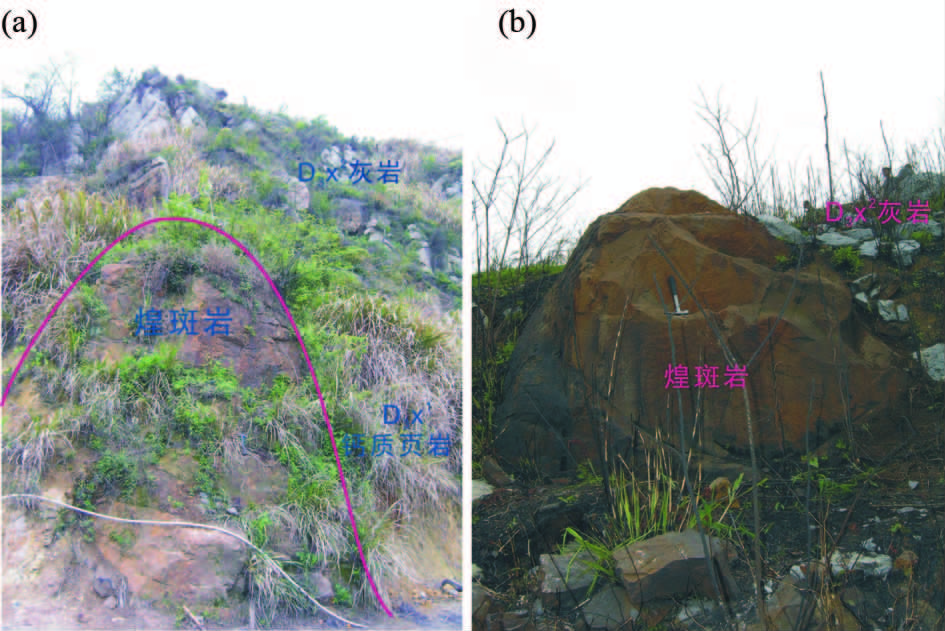
|
图 3 锡矿山煌斑岩的野外露头
(a)老江冲公路旁的煌斑岩;(b)独立小屋附近出露的煌斑岩 Fig. 3 The outcrop of the lamprophyre in the Xikuangshan district |
|
|
表 1 锡矿山煌斑岩的主量元素分析结果(wt%) Table 1 Major oxide(wt%)composition analyses of the lamprophyre in the Xikuangshan district |
尽管该区出露的煌斑岩由于风化往往呈土黄色、黄褐色,但新鲜的煌斑岩呈灰黑色,煌斑结构明显(图 4a,b);斑晶主要为黑云母、斜长石,次要矿物为石英。煌斑岩手标本中可见浅色的长英质捕虏体,部分手标本还可见浅色的热液脉体。
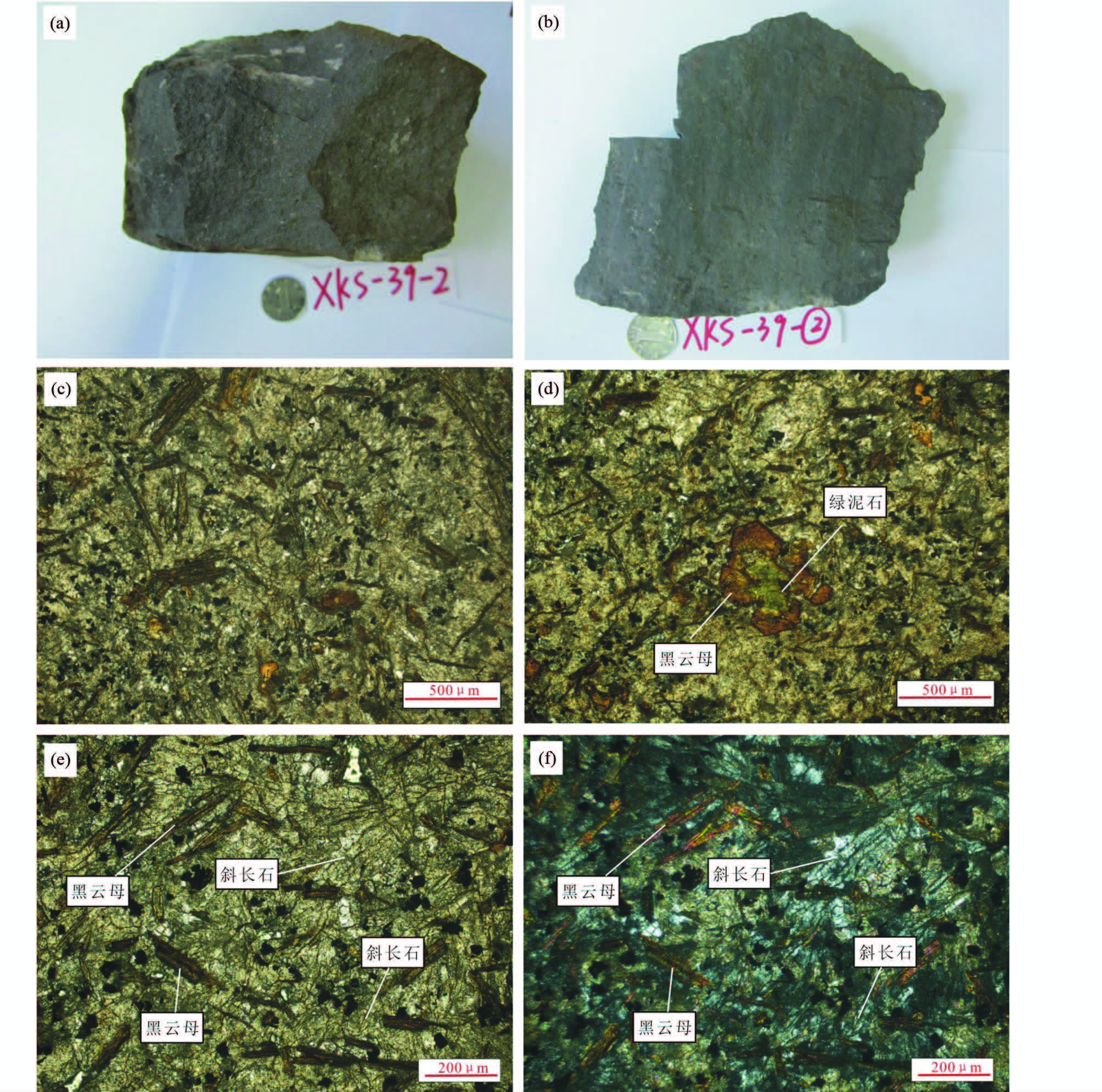
|
图 4 锡矿山煌斑岩的手标本及镜下照片
(a、b)新鲜的煌斑岩手标本;(c-f)煌斑岩镜下照片,c-e为单偏光,f为正交偏光 Fig. 4 The hand-specimen(a,b)and its micrograph(c-f)of the lamprophyre in the Xikuangshan district |
该煌斑岩具典型的煌斑结构(图 4c-f),斑晶主要为黑云母、斜长石、少量辉石及钾长石,其中长石大多已发生蚀变,黑云母相对较新鲜,但也可见少量黑云母内部存在绿泥石化(图 4d);基质主要为黑云母、斜长石、辉石、钾长石等;副矿物主要有磁铁矿、钛铁矿、磷灰石、锆石等。根据锡矿山煌斑岩的手标本特征及镜下鉴定结果,可将该煌斑岩定名为云斜煌斑岩(湖南省地质研究所,1983; 吴良士和胡雄伟,2000; 谢桂青等,2001; 本文)。
3 测试方法煌斑岩的主量元素分析采用X射线荧光光谱法(ZSX Primus Ⅱ),在中南大学有色金属成矿预测教育部重点实验室完成;微量元素分析采用电感耦合等离子体质谱法(ELAN DRC-e型Q-ICP-MS),在中国科学院地球化学研究所矿床地球化学国家重点实验室完成。主量元素分析的重现性优于3%,微量元素分析精度优于5%。
煌斑岩样品的Rb-Sr同位素和Sm-Nd同位素分析在天津地质矿产研究所同位素室完成,所使用的仪器为Thermo Fisher公司生产的Triton热电离质谱仪。Rb、Sr、Sm、Nd含量采用同位素稀释法测定,Nd和Sr同位素比值是对提纯的样品直接测定。样品采用HF+HClO4法溶样,Nd的纯化采用HDEHP反色层法,以确保没有144Sm对144Nd的干扰。详细的化学前处理过程参见Peng et al.(2002)。
4 分析结果 4.1 主量元素主量元素的分析表明,锡矿山煌斑岩SiO2含量为46.51%~51.72%(表 1),与国内外大部分煌斑岩的SiO2含量相似(Rock,1987; 黄智龙等,1996; Guo et al.,2004; 贾丽琼等,2013; Ma et al.,2014a)。该区大部分煌斑岩样品以高Ti为特征,TiO2>1.46%,Ti/Y>350(表 1),因此该煌斑岩应为高钛煌斑岩,这与镜下常见暗色黑云母、钛铁矿、磁铁矿等矿物分布相吻合。该区煌斑岩的Al2O3=10.00%~12.24%,FeOT=7.97%~8.80%,MgO=3.07%~4.62%,CaO=5.24%~9.89%,Na2O=0.07%~2.68%,K2O=0.37%~2.41%,K2O+Na2O=0.44%~5.09%,P2O5=0.72%~0.98%,具高的LOI值(9.82%~18.67%)。与Rock(1987)统计的钙碱性煌斑岩相比(表 1),该区煌斑岩表现出明显富TiO2、贫Al2O3和MgO的特点。
本次测试的煌斑岩样品,其K2O和Na2O的含量变化较大(表 1),前人的测试数据亦存在类似现象(吴良士和胡雄伟,2000)。根据其K2O+Na2O的含量,该区煌斑岩可分为A、B两组(图 5):A组K2O+Na2O含量较高,一般大于4.5%;B组K2O+Na2O含量较低,通常小于1%。结合手标本特征和显微岩相鉴定结果,我们发现A组样品为较新鲜的煌斑岩,基本上未受后期蚀变的影响,而B组为受蚀变影响较明显的煌斑岩。
在CaO-(Na2O+K2O)(图 5a)和LOI-(Na2O+K2O)(图 5b)图解中,锡矿山新鲜煌斑岩和蚀变煌斑岩明显落入两个不同的区域:Na2O+K2O高的新鲜煌斑岩样品,其CaO和挥发份含量都偏低;而Na2O+K2O低的蚀变煌斑岩样品,其CaO和挥发份明显偏高,这暗示该区煌斑岩的蚀变很可能与碳酸盐化有关,该区煌斑岩的CaO与挥发份呈正相关关系(图 5c)也佐证了这点(Lahaye and Arndt,1996)。同时该区煌斑岩K2O与CaO呈明显的负相关关系(图 5d),显示其蚀变作用也可能与绿泥石化有关。值得一提地是,尽管该区新鲜煌斑岩和蚀变煌斑岩的Na2O、K2O、CaO和挥发份含量相差较大,但其它主量元素和微量元素组成没有明显差别。

|
图 5 锡矿山煌斑岩的CaO、碱含量及挥发分三者之间的关系图
数据来自湖南省地质研究所(1983)、湖南有色246队(1985①)①湖南省地质研究所. 1983. 湖南省锡矿山锑矿田地质特征及成矿规律(内部科研报告)、吴良士和胡雄伟(2000)、谢桂青等(2001)以及本文 Fig. 5 The relationship between CaO,Na2O+K2O and volatile for lamprophyres in the Xikuangshan district |
煌斑岩的分类通常是借助Rock(1987)的TAS(全碱-SiO2)图解进行判别(Ashley et al.,1994; 管涛等,2003; 刘燊等,2005; 刘畅等,2006; Kerr et al.,2010; 杨一增等,2013)。如前所述,该区部分煌斑岩样品由于遭受蚀变而导致其全碱含量显著降低,因此我们在此仅利用新鲜煌斑岩样品(A组)进行TAS图解的投影。从TAS图解中(图 6)不难发现,锡矿山新鲜煌斑岩样品在Middlemost(1994)图解中大多落入粗面安山岩和玄武岩的范围,而在Rock(1987)图解中均落入钙碱性煌斑岩的范围。

|
图 6 锡矿山煌斑岩的TAS图解(底图据Rock,1987; Middlemost,1994) CAL-钙碱性煌斑岩;UML-超基性煌斑岩;AL-碱性煌斑岩;LL-钾镁煌斑岩 Fig. 6 (K2O+Na2O)vs. SiO2 classification diagram of lamprophyres in the Xikuangshan district(base map after Rock,1987; Middlemost,1994) |
虽然该区部分煌斑岩发生了蚀变,但除K、Rb、Ba、Sr外,该区蚀变煌斑岩和新鲜煌斑岩的微量元素组成差别甚微(表 2),即后期蚀变作用对该区煌斑岩的大部分微量元素影响不大,其微量元素组成基本可以反映锡矿山煌斑岩的源区特征。
|
|
表 2 锡矿山煌斑岩微量和稀土元素含量分析结果(×10-6) Table 2 Trace element concentrations(×10-6)for the lamprophyres in the Xikuangshan district |
从表 2可知,锡矿山煌斑岩中过渡族元素Ti(8753×10-6~11450×10-6)、Cu(51.8×10-6~109.0×10-6)和Zn(143×10-6~168×10-6)的含量略高于原始地幔值,而Cr(91×10-6~115×10-6)和Ni(69.1×10-6~87.1×10-6)的含量则远低于原始地幔值(Taylor and McLennan,1985),这与许多幔源基性岩、超基性岩、碱性岩的过渡元素含量特征一致。与Rock(1987)统计的钙碱性煌斑岩相比,该区煌斑岩的过渡元素含量与其大体相当,仅Zn含量略有偏高,而Cr、Ni含量显著偏低(图 7)。
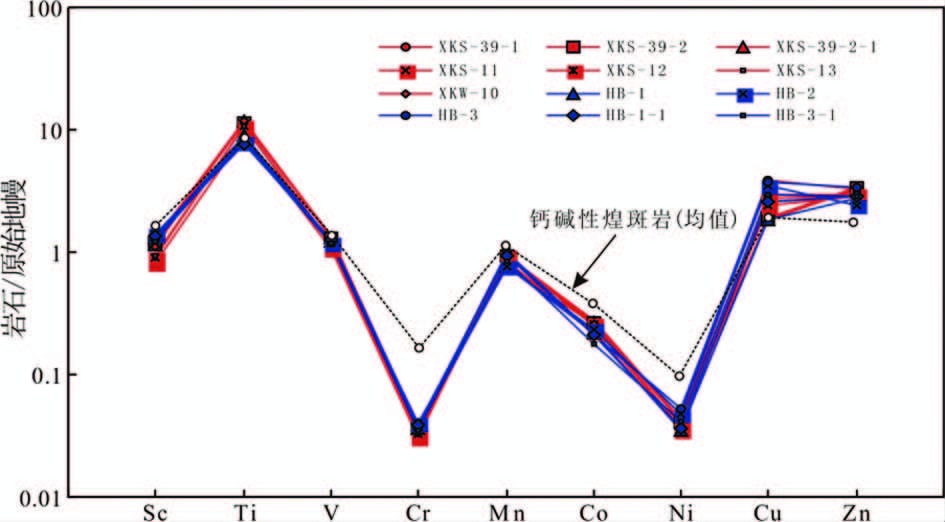
|
图 7 锡矿山煌斑岩的原始地幔标准化过渡元素蛛网图(标准化值据Sun and McDonough,1989) Fig. 7 Primitive mantle-normalized spidergrams of lamprophyres in the Xikuangshan district(normalization values after Sun and McDonough,1989) |
在过渡元素蛛网图中(图 7),所有样品的标准化曲线均呈“W”型,表现为Cr和Ni相对亏损,而Ti、Cu和Zn相对富集。根据晶体场的相关理论,人们一般认为,地幔矿物比经地幔部分熔融而形成的岩浆更富Cr和Ni,这是因为Cr3+、Ni3+等八面体择位能较大,更倾向于保存于地幔矿物中,故经部分熔融形成的岩浆往往会相对亏损Cr和Ni(葛良胜等,2003)。因此,根据锡矿山煌斑岩过渡族元素的配分特点(图 7),我们可推断该煌斑岩的母岩浆为经地幔派生的岩浆。
锡矿山煌斑岩亲石元素的含量,与Rock(1987)统计的钙碱性煌斑岩的平均值大体相近(表 2、图 8),而明显高于Sun and McDonough(1989)报道的原始地幔、亏损型洋中脊玄武岩(N-MORB)、富集型洋中脊玄武岩(E-MORB)以及岛弧玄武岩(OIB)中的相应值。

|
图 8 锡矿山煌斑岩的原始地幔标准化微量元素蛛网图(标准化值据Sun and McDonough,1989) Fig. 8 Primitive mantle-normalized spidergrams of lamprophyres in the Xikuangshan district(normalization values after Sun and McDonough,1989) |
相对于原始地幔而言,该区煌斑岩的大离子亲石元素(LILE)与高场强元素(HFSE)含量均较高;且相对于Nb、Ta、P等高场强元素而言,其Sr、Rb、Ba、Pb等大离子亲石元素表现出明显富集的特征。
锡矿山煌斑岩的稀土元素含量为384.6×10-6~518.4×10-6,其中轻稀土含量为354.7×10-6~471.6×10-6,远高于重稀土含量(29.90×10-6~46.80×10-6),表现出LREE明显富集的特征。该区煌斑岩的稀土元素总量和轻稀土元素含量,明显高于云南老王寨煌斑岩(黄智龙等,1999)、胶东玲珑和蓬莱煌斑岩(Ma et al.,2014b),但大体与苏鲁造山带中的煌斑岩(Guo et al.,2004)和Rock(1987)统计的钙碱性煌斑岩相当。
该区煌斑岩球粒陨石标准化的稀土配分模式均为右倾的LREE富集型(图 9);其(La/Yb)N=36.6~61.6,表明该煌斑岩轻、重稀土分异强烈;(La/Sm)N和(Gd/Yb)N分别为6.0~7.9和2.76~5.27,指示其LREE内部分异明显,但HREE内部分异相对较弱。另外该区煌斑岩表现出弱的Eu负异常(δEu=0.78~0.82),反映出锡矿山煌斑岩经历过较弱的斜长石结晶分异作用。
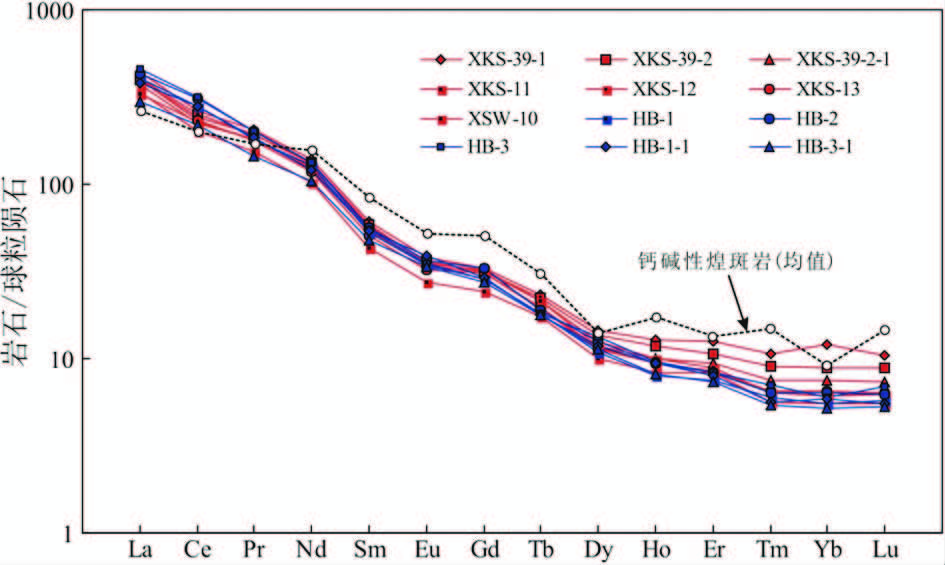
|
图 9 锡矿山煌斑岩球粒陨石标准化稀土元素配分模式图(标准化值据Boynton,1984) Fig. 9 Chondrite-normalized REE patterns of lamprophyres in the Xikuangshan district(normalization values after Boynton,1984) |
前人研究表明,在部分熔融作用和结晶分异作用过程中,不相容元素La和Sm的地球化学行为是不同的,因此,可利用La-La/Sm图解来判断岩浆岩的形成机制(Treuil and Joron,1975; 赵振华,1997)。在La-La/Sm图解中,锡矿山煌斑岩样品大体上呈正相关关系,如果排除样品XKS-11,这种正相关性更加显著(图 10),表明该区煌斑岩的形成方式主要是部分熔融作用。
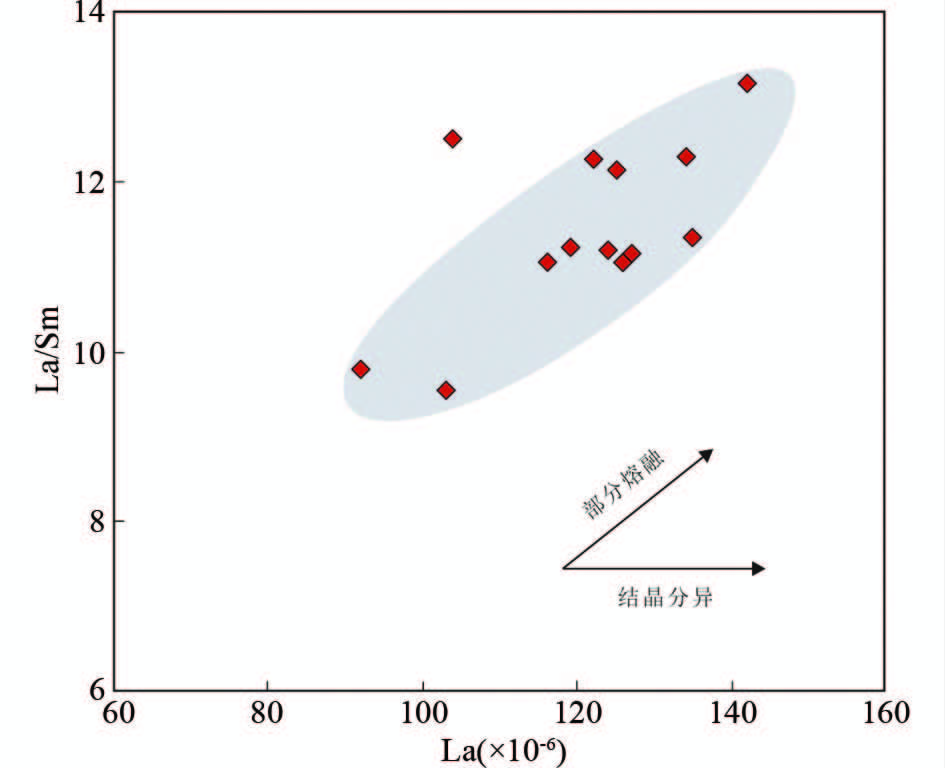
|
图 10 锡矿山煌斑岩的La-La/Sm图解
数据来自本文和谢桂青等,2001,图 11、图 15同 Fig. 10 La vs. La/Sm diagram of lamprophyres in the Xikuangshan district |
锡矿山煌斑岩的87Rb/86Sr和87Sr/86Sr分别为0.0379~0.2706和0.71013~0.71041,147Sm/144Nd为0.0871~0.0901,143Nd/144Nd为0.51242~0.51251(表 3);根据吴良士和胡雄伟(2000)测定的煌斑岩K-Ar同位素年龄(128Ma),可计算出该煌斑岩的(87Sr/86Sr)i为0.7097~0.71028,εNd(t)值为-2.54~-0.80(表 3)。
|
|
表 3 锡矿山煌斑岩的Rb-Sr和Sm-Nd同位素组成 Table 3 The Sm-Nd isotope composition for the lamprophyres in the Xikuangshan district |
通常情况下,基性岩浆在上升过程中都不可避免地会遭受不同程度的地壳混染(DePaolo,1981; Rudnick et al.,1986; Amelin et al.,1996)。锡矿山煌斑岩具有一些类似地壳的地球化学特征,如Nb-Ta负异常、Pb正异常、高(87Sr/86Sr)i和低εNd(t)值,以及不同样品εNd(t)值变化较大,似乎均指示其可能受到地壳混染作用的影响。但该区煌斑岩的稀土元素高含量特征,可排除大量围岩被同化混染的可能,因为湘中盆地有厚达5km以上的碳酸盐岩地层,这些碳酸盐岩中的稀土元素含量很低,最高仅为n×10-5(金景福等,1999),而煌斑岩的稀土元素含量高达384.6×10-6~518.4×10-6,显然可以排除围岩灰岩被大量混入煌斑岩的可能。
前人研究显示,大量地壳物质的混染会导致岩浆岩样品的SiO2-(87Sr/86Sr)i正相关和SiO2-εNd(t)负相关(Ma et al.,2014b)。从图 11不难发现,锡矿山煌斑岩SiO2与(87Sr/86Sr)i和εNd(t)均没有明显的相关性,因此在锡矿山煌斑岩的成岩过程中,地壳混染作用应该是相当有限的。

|
图 11 锡矿山煌斑岩的SiO2与Sr、Nd同位素图解 Fig. 11 Plot of(87Sr/86Sr)i and εNd(t)vs. SiO2 for lamprophyres in the Xikuangshan district |
锡矿山煌斑岩的Nb/Ta和Zr/Hf平均值分别为16.8和44.0,均远大于陆壳的相应值(11和33,Taylor and McLennan,1985),而接近原始地幔值(17.5±2.0和36.27±2.0,Sun and McDonough,1989),也证实不可能有很多壳源物质混染到煌斑岩中。
已有研究表明,根据MgO与其它元素的相关关系,可判断岩浆的结晶分异过程。锡矿山煌斑岩CaO、Rb、Th、TiO2与MgO的负相关关系(图 12),显示斜长石是其主要的分离结晶相。根据Cr、Ni与MgO的正相关关系(图 12)可判断橄榄石也是其主要的结晶相;锡矿山地区深部存在隐伏的橄榄石云斜煌斑岩(湖南省地质研究所,1983),也充分证实了这点。根据FeOT与MgO的正相关关系(图 12)可推断,单斜辉石不应是其主要的结晶相;另外,磷灰石也不应是其主要的结晶相,因为该煌斑岩中P2O5的含量变化并不大。因此,锡矿山煌斑岩岩浆上升过程中可能发生了橄榄石+斜长石的结晶分异作用。
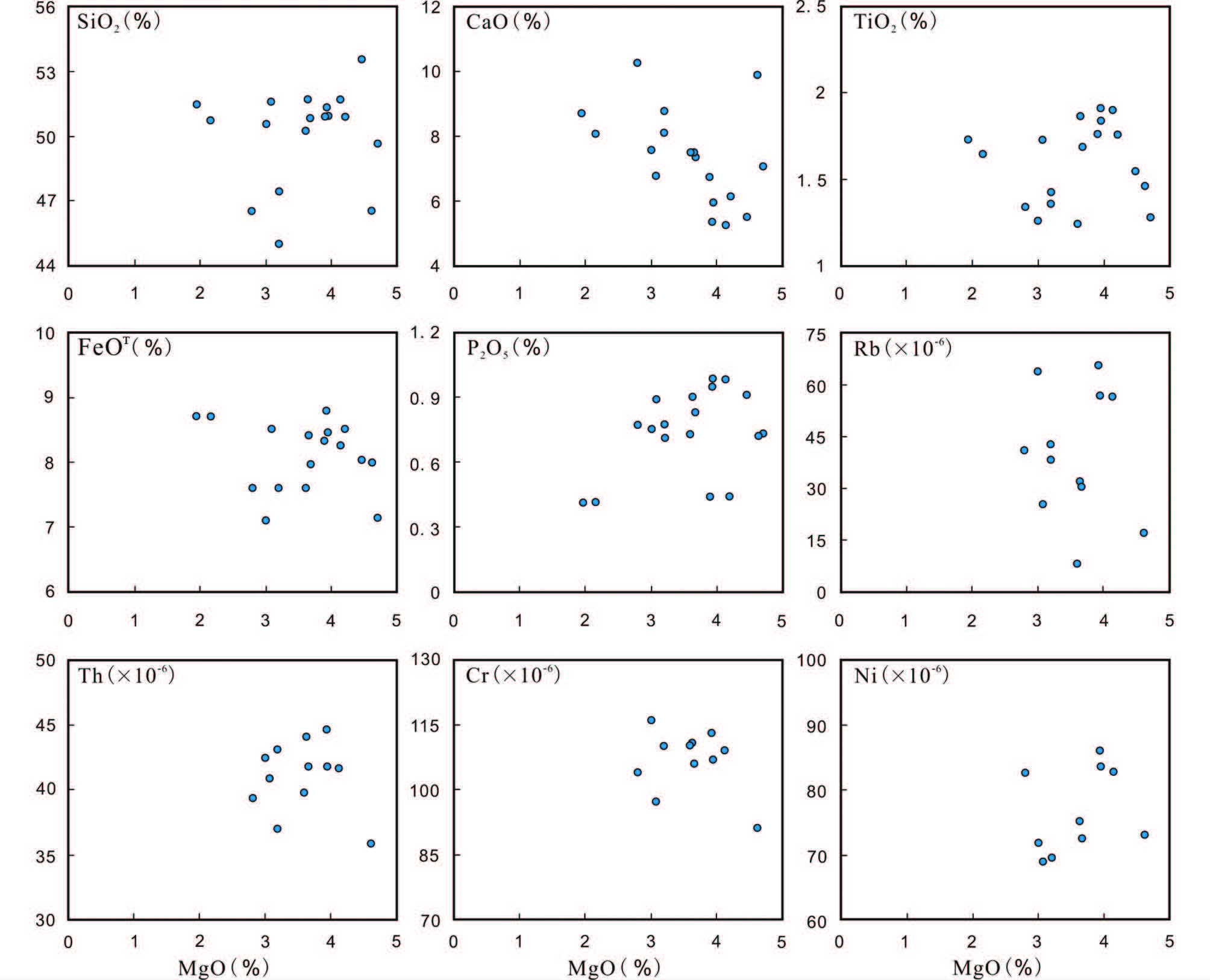
|
图 12 锡矿山煌斑岩主量元素和微量元素相对MgO的变异图解
数据综合湖南省地质研究所(1983)、湖南有色246队(1985)、吴良士和胡雄伟(2000)、谢桂青等(2001)以及本文 Fig. 12 Variation diagrams of major- and trace-elements vs. MgO for lamprophyres in the Xikuangshan district |
与大洋中脊玄武岩(MORB)相比,现代岛弧玄武岩具有LILE和LREE富集、HFSE亏损、高(87Sr/86Sr)i和低εNd(t)值的特征,这些地球化学特征反映了源区富集是通过沉积物的俯冲作用形成的(Guo et al.,2014)。俯冲沉积物一直被视为某些大洋岛弧玄武岩(如EM1型和EM2型OIB)地幔源区的一个重要组成部分(Zindler and Hart,1986; Weaver,1991; Hofmann,1997; Jackson and Dasgupta,2008; Guo et al.,2014)。根据锡矿山煌斑岩具有LILE和LREE富集、HFSE亏损、高(87Sr/86Sr)i和低εNd(t)值的特征,可推断该煌斑岩应来自富集地幔,且这种富集地幔应该与沉积物的俯冲作用有关。
在Sr-Nd同位素组成图解中,锡矿山煌斑岩样品远离扬子地块上、下陆壳范围,而是靠近EM2区域(图 13),表明该区煌斑岩的源区很可能为EM2型富集地幔,这一认识与湖南其它中生代煌斑岩来自EM2型地幔源区(梁新权等,2003)相吻合,亦与中生代华南板块岩石圈地幔为EM2型相一致(Ling et al.,2009)。

|
图 13 锡矿山煌斑岩的Sr-Nd同位素图解
资料来源:EM1、EM2、HIMU和DMM地幔端元组分(Zindler and Hart,1986; Hart,1988);MORB、夏威夷火山岩和凯尔盖郎火山岩(White and Hoffam,1982);纳瓦霍云煌岩(Alibert et al.,1986);Vulsini火山岩(Rogers et al.,1985);西澳钾镁煌斑岩(Fraser et al.,1985);苏鲁造山带煌斑岩(Ma et al.,2014b; Guo et al.,2004);扬子地块上地壳和下地壳(Gao et al.,1999);锡矿山煌斑岩来自本文和谢桂青等(2001) Fig. 13 Plot of(87Sr/86Sr)i vs. εNd(t)for the lamprophyres in the Xikuangshan district |
前人研究表明,岩石圈地幔中的LILE主要由金云母、角闪石等富含挥发分的矿物提供(Foley et al.,1996; Ionov et al.,1997)。由于Rb和Ba在金云母中是相容元素,而Rb、Ba和Sr在角闪石中是中等相容元素(LaTourrette et al.,1995),因此,含角闪石的源区发生平衡熔融时,将会形成高Ba/Rb比和极低Rb/Sr比的熔体,而源区含金云母时将导致生成的熔体其Ba含量和Ba/Rb比极低(Furman and Graham,1999)。尽管锡矿山煌斑岩样品Rb/Sr比大多偏低、Ba/Rb比偏高,与金云母相地幔熔融生成的熔体特征不太吻合,但这很可能是煌斑岩后期蚀变导致其Rb丢失所致。从Ba/Rb-Rb/Sr图解(图 14)不难看出,该煌斑岩的母岩与含金云母相的母岩演化趋势更为吻合,因此锡矿山煌斑岩源区应存在金云母相。值得一提地是,该区煌斑岩与源区含金云母相的苏鲁造山带煌斑岩的Ba/Rb-Rb/Sr变化范围(Guo et al.,2004)大体相似,这也从侧面说明该区煌斑岩可能来自于含金云母相的地幔源区。
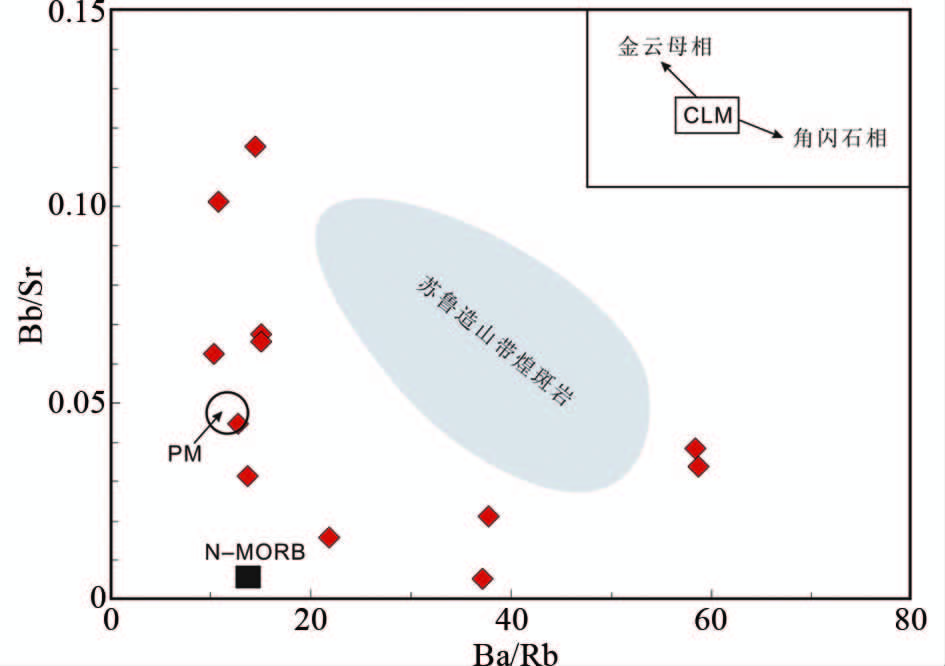
|
图 14 锡矿山煌斑岩的Rb/Sr-Ba/Rb图解
PM-原始地幔;CLM-正常岩石圈;数据来源:原始地幔和N-MORB原始值(Sun and McDonough,1989),苏鲁造山带煌斑岩(Guo et al.,2004),锡矿山煌斑岩来自本文及谢桂青等(2001) Fig. 14 Rb/Sr vs. Ba/Rb diagram of lamprophyres in the Xikuangshan district |
在含金云母相的二辉橄榄岩部分熔融中,K/Yb-Dy/Yb图解可以有效地将尖晶石稳定场和石榴石稳定场区别开来(Duggen et al.,2005; Jiang et al.,2010)。由于锡矿山煌斑岩的K含量明显受到后期蚀变作用影响,因此,我们只能借助Dy/Yb比值来限定地幔源区的成分。在部分熔融中石榴石的稳定场通常会产生较高的Dy/Yb比值(>2.5),而尖晶石的稳定场通常会产生较低的Dy/Yb比值(<1.5)。锡矿山煌斑岩样品Dy/Yb比值均大于1.8,绝大部分大于2.5,表明该煌斑岩是在石榴石稳定场的条件下经部分熔融形成的,其源区深度至少大于80km(Klemme and O’Neill,2000)。前人研究表明,煌斑岩LREE/球粒陨石>100,HREE/球粒陨石≤10时,指示其熔融源区有残余的石榴石存在(McKenzie and O’Nions,1991; Guo et al.,2004);锡矿山煌斑岩的稀土元素亦具备上述特征,暗示其源区也应存在残余的石榴石。因此,锡矿山煌斑岩的初始富集源区为在石榴石稳定场条件下含金云母相的二辉橄榄岩部分熔融的产物。
5.3 深部动力学过程探讨由上文可知,锡矿山煌斑岩的源区为EM2型地幔,这种富集地幔的形成与沉积物的俯冲作用有关。俯冲作用包括陆壳俯冲和洋壳俯冲。前人的研究表明,陆壳俯冲进入地幔形成的流体具有极低的εNd(t)值(Jahn et al.,1999; Qiu et al.,2002),而锡矿山煌斑岩的εNd(t)值偏高,因此,我们可以排除陆壳俯冲的这种可能性。该区煌斑岩高Pb和Th含量、高LILE/HFSE比和Pb/Ce比的元素特征,也证实其源区存在海相沉积物(McCulloch and Gamble,1991; Othman et al.,1989)。因此,锡矿山煌斑岩的源区富集应与洋壳俯冲作用有关。
大量的研究表明,中国东部从晚侏罗世-白垩纪受到古太平洋板块的西向俯冲(Xu et al.,1987; Zhou and Li,2000; Zhu et al.,2005; Zhou et al.,2006; Wang et al.,2007,2011; Sun et al.,2007)(图 1);且有研究表明,古太平洋板块朝中国东部俯冲作用影响的距离可远达1300km(Li and Li,2007),甚至有人推测这种俯冲作用影响范围更大,可远及秦岭造山带(Liu et al.,2013)和广西中、东部(Li et al.,2014)。如Li et al.(2014)通过对广西中、东部白垩纪煌斑岩研究也发现,该区煌斑岩的形成受到古太平洋西向俯冲的影响。
前人的研究表明,利用Th/Zr-Nb/Zr判别图解,可以将沉积物俯冲过程中熔体的富集作用及与流体有关的交代作用有效地区分开来(Ma et al.,2014b)。从图 15不难发现,锡矿山煌斑岩Nb/Zr比较稳定,而Th/Zr比变化较大,因此其地幔源区的富集作用显然是与流体交代作用有关。

|
图 15 锡矿山煌斑岩的Th/Zr-Nb/Zr图解(据Ma et al.,2014b) Fig. 15 Th/Zr vs. Nb/Zr diagram of lamprophyres in the Xikuangshan district(after Ma et al.,2014b) |
尽管锡矿山煌斑岩的Nb/Ta比值接近原始地幔值,但其Zr/Hf比值稍高于后者。前人的研究显示,这种偏高的Zr/Hf值通常与小体积的碳酸盐流体交代富集作用有关(Dupuy et al.,1992; Rudnick and Fountain,1995; Furman and Graham,1999)。因此,根据锡矿山煌斑岩的Zr/Hf值,也可判断其地幔源区曾发生过流体的交代作用。该区煌斑岩Th强烈富集(35.8×10-6~44.6×10-6)的特征,也证实了该区确实存在俯冲带流体交代岩石圈地幔的地质事实(Davies and MacDonald,1987; 李献华等,1997; 梁新权等,2003)。
因此,湘中锡矿山矿区煌斑岩的形成与古太平洋板块在晚侏罗世-白垩纪西向俯冲有关,这种洋壳俯冲作用形成的流体交代初始富集源区,使其某些亲石元素得到进一步富集,最终形成煌斑岩的富集地幔源区。
5.4 煌斑岩与锑矿化的关系关于锡矿山煌斑岩与该区锑矿的关系,前人存在两种截然不同的认识:一种观点认为,两者关系密切,该区煌斑岩为地幔流体参与锑成矿的标志(黎盛斯,1996);另外一种观点认为该区煌斑岩与锑矿并无成因联系,大部分学者认为煌斑岩先于锑矿形成,煌斑岩是锑矿化的东部边界,在成矿过程阻止成矿流体继续往东运移(刘光模和简厚明,1983; 史明魁等,1994),但也有一些研究者认为,煌斑岩形成于锑矿之后(凌水成,1999; 吴良士和胡雄伟,2000)。下面笔者将从时空关系、形成的构造环境和成因联系等方面来论述两者的关系。
已有的资料表明,该区煌斑岩的黑云母K-Ar年龄为128Ma(吴良士和胡雄伟,2000);而锡矿山矿区存在两期独立成矿事件,主成矿期形成于155.5±1.1Ma,而晚期成矿时间为124.1±3.7Ma(Peng et al.,2002),显然,该区煌斑岩脉在形成时间上明显晚于主成矿期,大致与晚期成矿时间相当或稍早于晚期成矿。煌斑岩形成于两期成矿事件之间的结论,能很好地解释已有的地质现象:(1)在煌斑岩的东部仍存在锑的化探异常;在锡矿山矿田东部的石油钻孔中也见到了锑矿化(谌锡林等,1983)。这说明煌斑岩形成之前就存在锑矿化,煌斑岩脉确实不是锑矿的东部边界;(2)煌斑岩岩脉中碳酸盐化较强烈,存在热液成因的石英-萤石脉体和方解石脉体;在靠近物华矿区,煌斑岩中Sb的含量明显偏高,而远离矿区,锑含量较低(刘光模和简厚明,1983),这说明锡矿山煌斑岩形成之后,确实受到后期热液活动的影响。
我们已有的研究表明,锡矿山主成矿期矿石的(87Sr/86Sr)i为0.71212~0.71282,εNd(t)为-15.5;晚期矿石(87Sr/86Sr)i为0.71020~0.71061,εNd(t)为-15.0(Peng et al.,2003)。在(87Sr/86Sr)i-εNd(t)图解中,锡矿山煌斑岩与该区锑矿石完全落在不同的区域。因此,煌斑岩与锑矿很可能没有成因关系,煌斑岩中锑含量偏高,应该是煌斑岩受到后期成矿热液的影响所致。离矿区越近,煌斑岩中锑含量越高,也充分证实了这点。我们早前的研究表明,锡矿山锑矿的成矿物质主要来自湘中盆地深部的元古宇基底(彭建堂等,2001,2002),没有地幔物质的参与,这也排除幔源煌斑岩提供成矿物质的可能性。
大量研究表明,煌斑岩是形成于拉张伸展的构造环境中(Ashley et al.,1994; 贾大成等,2002; Guo et al.,2004; 刘燊等,2005; 刘畅等,2006; 张贵山等,2007; Ma et al.,2014b),单业华和易建斌(1994)、彭建堂等(2014)的研究工作亦表明,锡矿山煌斑岩和锑矿均形成于拉张伸展的构造环境。
因此,锡矿山煌斑岩形成于两期成矿作用之间,两者仅存在空间上的耦合关系,前者并没有为该区锑矿提供物质和能量,但两者形成的构造背景相同,均形成于岩石圈拉张伸展的构造环境中。
6 结论(1)湘中锡矿山煌斑岩为钙碱性煌斑岩,在其形成过程中地壳混染作用相当有限,岩浆在上升侵位的过程中经历了橄榄石+斜长石的结晶分异作用。
(2)锡矿山煌斑岩源区为类似EM2型的富集地幔;其初始源区为在石榴石稳定场条件下含金云母相的二辉橄榄岩地幔部分熔融的产物,晚侏罗世-白垩纪古太平洋板块西向俯冲,导致洋壳俯冲沉积物形成的流体交代这种初始地幔源区,从而形成煌斑岩的最终富集源区。
(3)锡矿山煌斑岩与该区锑矿没有成因联系,但两者均形成于岩石圈拉张伸展的构造环境中。
致谢 野外工作得到了湖南锡矿山闪星锑业有限责任公司的大力支持;中国地质大学(武汉)赵军红教授对论文初稿进行了修改并提供了宝贵意见;郭锋研究员及另一位匿名评审专家对论文的修改和完善提出了很多建设性的意见;在此一并致以诚挚的谢意!
| [1] | Alibert C, Michard A and Albaréde F. 1986. Isotope and trace element geochemistry of Colorado Plateau volcanics. Geochimica et Cosmochimica Acta, 50(12): 2735-2750 |
| [2] | Amelin YV, Neymark LA, Ritsk EY et al. 1996. Enriched Nd-Sr-Pb isotopic signatures in the Dovyren layered intrusion (eastern Siberia, Russia): Evidence for source contamination by ancient upper-crustal material. Chemical Geology, 129(1-2): 39-69 |
| [3] | Ashley PM, Cook NDJ, Hill RL et al. 1994. Shoshonitic lamprophyre dykes and their relation to mesothermal Au-Sb veins at Hillgrove, New South Wales, Australia. Lithos, 32(3-4): 249-272 |
| [4] | Bergman SC. 1987. Lamproites and other potassium-rich igneous rocks: A review of their occurrence, mineralogy and geochemistry. Geological Society, London, Special Publications, 30(1): 103-190 |
| [5] | Boynton WV. 1984. Cosmochemistry of the rare earth elements: Meteorite studies. In: Henderson P (ed.). Rare Earth Element Geochemistry. Developments in Geochemistry. Amsterdam: Elsevier, 63-114 |
| [6] | Chen XL, Jiang YH, Li SY et al. 1983. A preliminary study on the origin of the Xikuangshan antimony deposit in Hunan. Geological Review, 29(5): 486-492 (in Chinese with English abstract) |
| [7] | Davies GR and MacDonald R. 1987. Crustal influences in the petrogenesis of the Naivasha basalt-comendite complex: Combined trace element and Sr-Nd-Pb isotope constraints. Journal of Petrology, 28(6): 1009-1031 |
| [8] | DePaolo DJ. 1981. Trace element and isotopic effects of combined wallrock assimilation and fractional crystallization. Earth and Planetary Science Letters, 53(2): 189-202 |
| [9] | Duggen S, Hoernle K, van den Bogaard P et al. 2005. Post-collisional transition from subduction- to intraplate-type magmatism in the westernmost Mediterranean: Evidence for continental-edge delamination of subcontinental lithosphere. Journal of Petrology, 46(6): 1155-1201 |
| [10] | Dupuy C, Liotard JM and Dostal J. 1992. Zr/Hf fractionation in intraplate basaltic rocks: Carbonate metasomatism in the mantle source. Geochimica et Cosmochimica Acta, 56(6): 2417-2423 |
| [11] | Foley SF, Venturelli G, Green DH et al. 1987. The ultrapotassic rocks: Characteristics, classification, and constraints for petrogenetic models. Earth-Science Reviews, 24(2): 81-134 |
| [12] | Foley SF, Jackson SE, Fryer JD et al. 1996. Trace element partition coefficients for clinopyroxene and phlogopite in an alkaline lamprophyre from Newfoundland by LAM-ICP-MS. Geochimica et Cosmochimica Acta, 60(4): 629-638 |
| [13] | Fraser KJ, Hawkesworth CJ, Erlank AJ et al. 1985. Sr, Nd and Pb isotope and minor element geochemistry of lamproites and kimberlites. Earth and Planetary Science Letters, 76(1-2): 57-70 |
| [14] | Furman T and Graham D. 1999. Erosion of lithospheric mantle beneath the East African Rift system: Geochemical evidence from the Kivu volcanic province. Developments in Geotectonics, 24: 237-262 |
| [15] | Gao S, Ling WL, Qiu YM et al. 1999. Contrasting geochemical and Sm-Nd isotopic compositions of Archean metasediments from the Kongling high-grade terrain of the Yangtze craton: Evidence for cratonic evolution and redistribution of REE during crustal anatexis. Geochimica et Cosmochimica Acta, 63(13-14): 2071-2088 |
| [16] | Ge LS, Zou YL, Li ZH et al. 2003. Geochemistry and genetic discussion of the Granite in Bengnazangbu and Jiagang area, Tibet. Journal of Mineralogy Petrology, 23(2): 55-61 (in Chinese with English abstract) |
| [17] | Guan T, Huang ZL, Xie LH et al. 2003. Geochemistry of lamprophyres in Baimazhai nickel deposit, Yunnan Province: I. Major and trace elements. Acta Mineralogica Sinica, 23(3): 278-288 (in Chinese with English abstract) |
| [18] | Guo F, Fan WM, Wang YJ et al. 2004. Origin of early Cretaceous calc-alkaline lamprophyres from the Sulu orogen in eastern China: Implications for enrichment processes beneath continental collisional belt. Lithos, 78(3): 291-305 |
| [19] | Guo F, Fan WM, Li CW et al. 2014. Hf-Nd-O isotopic evidence for melting of recycled sediments beneath the Sulu Orogen, North China. Chemical Geology, 381: 243-258 |
| [20] | Hart SR. 1988. Heterogeneous mantle domains: Signatures, genesis and mixing chronologies. Earth and Planetary Science Letters, 90(3): 273-296 |
| [21] | He WY, Mo XX, Yu XH et al. 2014. Genesis and geodynamic settings of lamprophyres from Beiya, western Yunnan: Constraints from geochemistry, geochronology and Sr-Nd-Pb-Hf isotopes. Acta Petrologica Sinica, 30(11): 3287-3300 (in Chinese with English abstract) |
| [22] | Hofmann AW. 1997. Mantle geochemistry: The message from oceanic volcanism. Nature, 385(6613): 219-229 |
| [23] | Huang ZL, Wang LK and Zhu CM. 1996. Study on geochemistry and genesis of lamprophyres in Machangqing gold deposits area, Yunnan Province. Journal of Mineralogy and Petrology, 16(2): 82-89 (in Chinese with English abstract) |
| [24] | Huang ZL, Zhu CM, Xiao HY et al. 1999. Do lamprophyric magma carry gold? Evidence from high temperature and ultrahigh pressure experiments. Chinese Science Bulletin, 44(22): 2073-2076 |
| [25] | Huang ZL, Liu CQ, Zhu CM et al. 1999. The Origin of Lamprophyres in the Laowangzhai Gold Field, Yunnan Province and Their Relations with Gold Mineralization. Beijing: Geological Publishing House, 30-112 (in Chinese) |
| [26] | Ionov DA, Griffin WL and O'Reilly SY. 1997. Volatile-bearing minerals and lithophile trace elements in the upper mantle. Chemical Geology, 141(3-4): 153-184 |
| [27] | Jackson MG and Dasgupt R. 2008. Compositions of HIMU, EM1, and EM2 from global trends between radiogenic isotopes and major elements in ocean island basalts. Earth and Planetary Science Letters, 276(1-2): 175-186 |
| [28] | Jahn BM, Wu FY, Lo CH et al. 1999. Crust-mantle interaction induced by deep subduction of the continental crust: Geochemical and Sr-Nd isotopic evidence from post-collisional mafic-ultramafic intrusions of the northern Dabie complex, central China. Chemical Geology, 157(1-2): 119-146 |
| [29] | Jia DC, Hu RZ, Lu Y et al. 2002. Petrological and geochemical characteristics of sodium-rich lamprophyres from Jiaoxiling in Northeast Hunan Province. Acta Petrologica Sinica, 18(4): 459-467 (in Chinese with English abstract) |
| [30] | Jia LQ, Mo XX, Dong GC et al. 2013. Genesis of lamprophyres from Machangqing, western Yunnan: Constraints from geochemistry, geochronology and Sr-Nd-Pb-Hf isotopes. Acta Petrologica Sinica, 29(4): 1247-1260 (in Chinese with English abstract) |
| [31] | Jiang YH, Jiang SY, Ling HF et al. 2010. Petrogenesis and tectonic implications of Late Jurassic shoshonitic lamprophyre dikes from the Liaodong Peninsula, NE China. Mineralogy and Petrology, 100(3-4): 127-151 |
| [32] | Jin JF, Tao Y, Lai WX et al. 1999. Metallogenic Regularities and Direction for Prospecting of Xikuangshan-type Antimony Deposits in central part of Hunan Province, China. Chengdu: Sichuan Press of Science & Technology, 1-122 (in Chinese) |
| [33] | Karsli O, Dokuz A, Kaliwoda M et al. 2014. Geochemical fingerprints of Late Triassic calc-alkaline lamprophyres from the Eastern Pontides, NE Turkey: A key to understanding lamprophyre formation in a subduction-related environment. Lithos, 196-197: 181-197 |
| [34] | Kerr AC, Khan M, Mahoney JJ et al. 2010. Late Cretaceous alkaline sills of the south Tethyan suture zone, Pakistan: Initial melts of the Réunion hotspot? Lithos, 117(1-4): 161-171 |
| [35] | Klemme S and O'Neill HSC. 2000. The near-solidus transition from garnet lherzolite to spinel lherzolite. Contributions to Mineralogy and Petrology, 138(3): 237-248 |
| [36] | Lahaye Y and Arndt NT. 1996. Alteration of a komatiite flow from Alexo, Ontario, Canada. Journal of Petrology, 37(6): 1261-1284 |
| [37] | LaTourrette T, Hervig RL and Holloway JR. 1995. Trace element partitioning between amphibole, phlogopite, and basanite melt. Earth and Planetary Science Letters, 135(1-4): 13-30 |
| [38] | Li SX. 1996. Evolution of antimony mineralization by the mantle plume of deep fluid in central Hunan. Hunan Geology, 15(3): 137-142 (in Chinese with English abstract) |
| [39] | Li XH and Sun XS. 1995. Lamprophyre and gold mineralization-An assessment of observations and theories. Geological Review, 41(3): 252-260 (in Chinese with English abstract) |
| [40] | Li XH, Hu RZ and Rao B. 1997. Geochronology and geochemistry of cretaceous mafic dikes from northern Guangdong, SE China. Geochimica, 26(2): 14-30 (in Chinese with English abstract) |
| [41] | Li XY, Zheng JP, Ma Q et al. 2014. From enriched to depleted mantle: Evidence from Cretaceous lamprophyres and Paleogene basaltic rocks in eastern and central Guangxi Province, western Cathaysia block of South China. Lithos, 184-187: 300-313 |
| [42] | Li ZX and Li XH. 2007. Formation of the 1300-km-wide intracontinental orogen and postorogenic magmatic province in Mesozoic South China: A flat-slab subduction model. Geology, 35(2): 179-182 |
| [43] | Liang XQ, Fan WM and Wang YJ. 2003. The deep process of the Mesozoic intracontinental tectonic deformation in Hunan: Geochemical tracer from the Lamprophyres. Acta Geoscientica Sinica, 24(6): 603-610 (in Chinese with English abstract) |
| [44] | Ling MX, Wang FY, Ding X et al. 2009. Cretaceous ridge subduction along the Lower Yangtze River belt, eastern China. Economic Geology, 104(2): 303-321 |
| [45] | Ling SC. 1999. Location of lamprophyre veins: The eastern boundary of the Xikuangshan ore field? Geological Exploration for Non-ferrous Metals, 8(6): 447-449 (in Chinese with English abstract) |
| [46] | Liu C, Zhao ZH and Guo ZJ. 2006. Chronology and geochemistry of lamprophyre dykes from Beishan area, Gansu Province and implications for the crust-mantle interaction. Acta Petrologica Sinica, 22(5): 1294-1306 (in Chinese with English abstract) |
| [47] | Liu GM and Jian HM. 1983. Geological characteristics of the Xikuangshan antimony ore field. Mineral Deposits, 2(3): 43-49 (in Chinese with English abstract) |
| [48] | Liu HP, Zhang YL and Hu WQ. 1985. On the origin of the stibnite deposit of Shikuangshan mine, Hunan. Hunan Geology, 4(1): 28-39 (in Chinese with English abstract) |
| [49] | Liu R, Li WJ, Bi SJ et al. 2013. Magma mixing revealed from in situ zircon U-Pb-Hf isotope analysis of the Muhuguan granitoid pluton, eastern Qinling Orogen, China: Implications for late Mesozoic tectonic evolution. International Journal of Earth Sciences, 102(6): 1583-1602 |
| [50] | Liu S, Hu RZ, Zhao JH et al. 2005. Geochemical characteristics and petrogenetic investigation of the Late Mesozoic lamprophyres of Jiaobei, Shandong Province. Acta Petrologica Sinica, 21(3): 947-958 (in Chinese with English abstract) |
| [51] | Lu FX, Shu XX and Zhao CH. 1991. A suggestion on classification of lamprophyres. Geological Science and Technology Information, 10(Suppl.): 55-62 (in Chinese with English abstract) |
| [52] | Ma L, Jiang SY, Hofmann AW et al. 2014a. Lithospheric and asthenospheric sources of lamprophyres in the Jiaodong Peninsula: A consequence of rapid lithospheric thinning beneath the North China Craton? Geochimica et Cosmochimica Acta, 124: 250-271 |
| [53] | Ma L, Jiang SY, Hou ML et al. 2014b. Geochemistry of Early Cretaceous calc-alkaline lamprophyres in the Jiaodong Peninsula: Implication for lithospheric evolution of the eastern North China Craton. Gondwana Research, 25(2): 859-872 |
| [54] | Mahéo G, Blichert-Toft J, Pin C et al. 2009. Partial melting of mantle and crustal sources beneath South Karakorum, Pakistan: Implications for the Miocene geodynamic evolution of the India-Asia convergence zone. Journal of Petrology, 50(3): 427-449 |
| [55] | McCulloch MT and Gamble JA. 1991. Geochemical and geodynamical constraints on subduction zone magmatism. Earth and Planetary Science Letters, 102(3-4): 358-374 |
| [56] | McKenzie DAN and O'Nions RK. 1991. Partial melt distributions from inversion of rare earth element concentrations. Journal of Petrology, 32(5): 1021-1091 |
| [57] | McNeil AM and Kerrich R. 1986. Archean lamprophyre dykes and gold mineralization, Matheson, Ontario: The conjunction of LILE-enriched mafic magmas, deep crustal structures, and Au concentration. Canadian Journal of Earth Sciences, 23(3): 324-343 |
| [58] | Middlemost EKA. 1994. Naming materials in the magma/igneous rock system. Earth Science Reviews, 37(3-4): 215-224 |
| [59] | Müller D and Groves DI. 1993. Direct and indirect associations between potassic igneous rocks, shoshonites and gold-copper deposits. Ore Geology Reviews, 8(5): 383-406 |
| [60] | Niu YL, Wilson M, Humphreys ER et al. 2011. The origin of intra-plate ocean island basalts (OIB): The lid effect and its geodynamic implications. Journal of Petrology, 52: 1443-1468 |
| [61] | Othman DB, White WM and Patchett J. 1989. The geochemistry of marine sediments, island arc magma genesis, and crust-mantle recycling. Earth and Planetary Science Letters, 94(1-2): 1-21 |
| [62] | Owen JP. 2008. Geochemistry of lamprophyres from the Western Alps, Italy: Implications for the origin of an enriched isotopic component in the Italian mantle. Contributions to Mineralogy and Petrology, 155(3): 341-362 |
| [63] | Peng JT, Hu RZ, Deng HL et al. 2001. Strontium isotope geochemistry of the Xikuangshan antimony deposit, central Hunan. Geochimica, 30(3): 248-256 (in Chinese with English abstract) |
| [64] | Peng JT, Hu RZ, Lin YX et al. 2002. Sm-Nd isotope dating of hydrothermal calcites from the Xikuangshan antimony deposit, Central Hunan. Chinese Science Bulletin, 47(13): 1134-1137 |
| [65] | Peng JT, Hu RZ, Zou LQ et al. 2002. Isotope tracing of ore-forming materials for the Xikuangshan antimony deposit, central Hunan. Acta Mineralogica Sinica, 22(2): 155-159 (in Chinese with English abstract) |
| [66] | Peng JT, Hu RZ and Burnard PG. 2003. Samarium-Neodymium isotope systematics of hydrothermal calcites from the Xikuangshan antimony deposit (Hunan, China): The potential of calcite as a geochronometer. Chemical Geology, 200(1-2): 129-136 |
| [67] | Peng JT, Hu AX, Zhang LS et al. 2014. Zircon U-Pb dating of the lamprophyre in the Xikuangshan mining district, central Hunan and its geological implications. Geotectonica et Metallogenia, 38(3): 686-693 (in Chinese with English abstract) |
| [68] | Qiu JS, Xu XS and Lo CH. 2002. Potash-rich volcanic rocks and lamprophyres in western Shandong Province: 40Ar-39Ar dating and source tracing. Chinese Science Bulletin, 47(2): 91-99 |
| [69] | Rao JR, Wang JH and Cao YZ. 1993. Deep structure in Hunan. Hunan Geology, 12(Suppl.): 1-101 (in Chinese with English abstract) |
| [70] | Rao JR, Luo JL and Yi ZJ. 1999. The mantle-crustal tectonic metallogenic model and ore-prospecting prognosis in the Xikuangshan orefield. Geophysical & Geochemical Exploration, 23(4): 241-249 (in chinese with English abstract) |
| [71] | Rock NMS. 1987. The nature and origin of lamprophyres: An overview. Geological Society, London, Special Publications, 30(1): 191-226 |
| [72] | Rock NMS and Groves DI. 1988a. Do lamprophyres carry gold as well as diamond? Nature, 332(6161): 253-255 |
| [73] | Rock NMS and Groves DI. 1988b. Can lamprophyres resolve the genetic controversy over mesothermal gold deposits? Geology, 16(6): 538-541 |
| [74] | Rock NMS, Bowes DR and Wright AE. 1991. Lamprophyres. Blackie: Glasgow, 1-285 |
| [75] | Rogers NW, Hawkesworth CJ, Parker RJ et al. 1985. The geochemistry of potassic lavas from Vulsini, central Italy and implications for mantle enrichment processes beneath the Roman region. Contributions to Mineralogy and Petrology, 90(2-3): 244-257 |
| [76] | Rudnick RL, McDonough WF, McCulloch MT et al. 1986. Lower crustal xenoliths from Queensland, Australia: Evidence for deep crustal assimilation and fractionation of continental basalts. Geochimica et Cosmochimica Acta, 50(6): 1099-1115 |
| [77] | Rudnick RL and Fountain DM. 1995. Nature and composition of the continental crust: A lower crustal perspective. Reviews of Geophysics, 33(3): 267-309 |
| [78] | Shan YH and Yi JB. 1994. Extensional structures and superlarge antimony mineralization in Xikuangshan, Hunan. Journal of Guilin College of Geology, 14(4): 355-358 (in Chinese with English abstract) |
| [79] | Shi MK, Fu BQ, Jin XX et al. 1994. Antimony Metallogeny in Central Part of Hunan Province. Changsha: Hunan Press of Science and Technology, 1-149 (in Chinese with English abstract) |
| [80] | Sun SS and McDonough WF. 1989. Chemical and isotopic systematics of oceanic basalts: Implications for mantle composition and processes. In: Saunders AD and Norry MJ (eds.). Magmatism in the Ocean Basins. Geological Society, London, Special Publications, 42(1): 313-345 |
| [81] | Sun WD, Ding X, Hu YH et al. 2007. The golden transformation of the Cretaceous plate subduction in the West Pacific. Earth and Planetary Science Letters, 262(3-4): 533-542 |
| [82] | Taylor SR and McLennan SM. 1985. The Continental Crust: Its Composition and Evolution. Oxford: Blackwell Scientific Publications, 1-312 |
| [83] | Taylor WR, Rock N, Groves DI et al. 1994. Geochemistry of Archean shoshonitic lamprophyres from the Yilgarn Block, Western Australia: Au abundance and association with gold mineralization. Applied Geochemistry, 9(2): 197-222 |
| [84] | Treuil M and Joron JL. 1975. Utilisation des éléments hygromagmatophiles pour la simplification de la modélisation quantitative des processus magmatiques. Italian Society of Mineralogy and Petrology, 31: 125-174 |
| [85] | Wang FY, Ling MX, Ding X et al. 2011. Mesozoic large magmatic events and mineralization in SE China: Oblique subduction of the Pacific plate. International Geology Review, 53(5-6): 704-726 |
| [86] | Wang YJ, Fan WM, Sun M et al. 2007. Geochronological, geochemical and geothermal constraints on petrogenesis of the Indosinian peraluminous granites in the South China Block: A case study in the Hunan Province. Lithos, 96(3-4): 475-502 |
| [87] | Weaver BL. 1991. The origin of ocean island basalt end-member compositions: Trace element and isotopic constraints. Earth and Planetary Science Letters, 104(2-4): 381-397 |
| [88] | White WM and Hofmann AW. 1982. Sr and Nd isotope geochemistry of oceanic basalts and mantle evolution. Nature, 296(5860): 821-825 |
| [89] | Wu LS and Hu XW. 2000. Xikuangshan mica-plagioclase lamprophyre and its granite inclusions, Hunan Province. Geology-Geochemistry, 28(2): 51-55 (in Chinese with English abstract) |
| [90] | Wyman D and Kerrich R. 1988. Alkaline magmatism, major structures, and gold deposits: Implications for greenstone belt gold metallogeny. Economic Geology, 83(2): 454-461 |
| [91] | Wyman DA and Kerrich R. 1989. Archean shoshonitic lamprophyres associated with Superior Province gold deposits: Distribution, tectonic setting, noble metal abundances, and significance for gold mineralization. Economic Geology Monograph, 6: 651-667 |
| [92] | Xie GQ, Peng JT, Hu RZ et al. 2001. Geochemical characteristics of lamprophyres in the Xikuangshan antimony ore deposits, Hunan Province. Acta Petrologica Sinica, 17(4): 629-636 (in Chinese with English abstract) |
| [93] | Xu JW, Zhu G, Tong WX et al. 1987. Formation and evolution of the Tancheng-Lujiang wrench fault system: A major shear system to the northwest of the Pacific Ocean. Tectonophysics, 134(4): 273-310 |
| [94] | Yang YZ, Long Q, Hu HT et al. 2013. Geochemical characteristics and origin of lamprophyre in the Laichau area, northwestern Vietnam. Acta Petrologica Sinica, 29(3): 899-911 (in Chinese with English abstract) |
| [95] | Yi JB, Fu SH and Shan YH. 2001. Research on the geochemical characteristics of the lamprophyre in the Xikuangshan superlarge stibnite ore deposit, Hunan, China. Geotectonica et Metallogenia, 25(3): 290-295 (in Chinese with English abstract) |
| [96] | Yuan XC and Hua JR. 2011. 3D lithospheric structure of south China. Geology in China, 38(1): 1-19 (in Chinese with English abstract) |
| [97] | Zhai JP, Hu K and Lu JJ. 1996. A discussion on the new genetic model for lamprophyres and gold mineralization. Mineral Deposits, 15(1): 80-86 (in Chinese with English abstract) |
| [98] | Zhang GS, Wen HJ, Hu RZ et al. 2007. Genesis and dynamic setting of mafic dikes in southeastern Fujian: Evidence from Sr-Nd isotopic and major and trace element geochemistry. Acta Petrologica Sinica, 23(4): 793-804 (in Chinese with English abstract) |
| [99] | Zhang Y, Chen B, Shao JA et al. 2003. Geochemistry and origin of Late Mesozoic lamprophyre dykes in Taihang Mountains, North China. Acta Petrologica et Mineralogica, 22(1): 29-33 (in Chinese with English abstract) |
| [100] | Zhao ZH. 1997. The Principle of Trace Elements Geochemistry. Beijing: Science Press, 112-169 (in Chinese) |
| [101] | Zhou XM and Li WX. 2000. Origin of Late Mesozoic igneous rocks in southeastern China: Implications for lithosphere subduction and underplating of mafic magmas. Tectonophysics, 326(3-4): 269-287 |
| [102] | Zhou XM, Sun T, Shen WZ et al. 2006. Petrogenesis of Mesozoic granitoids and volcanic rocks in South China: A response to tectonic evolution. Episodes, 29(1): 26-33 |
| [103] | Zhu G, Wang YS, Liu GS et al. 2005. 40Ar/39Ar dating of strike-slip motion on the Tan-Lu fault zone, East China. Journal of Structural Geology, 27(8): 1379-1398 |
| [104] | Zindler A and Hart S. 1986. Chemical geodynamics. Annual Review of Earth and Planetary Sciences, 14: 493-571 |
| [105] | 谌锡林, 蒋云杭, 李世永等. 1983. 湖南锡矿山锑矿成因探讨. 地质论评, 29(5): 486-492 |
| [106] | 葛良胜, 邹依林, 李振华等. 2003. 西藏崩纳藏布和甲岗雪山地区花岗岩的地球化学特征及成因初探. 矿物岩石, 23(2): 55-61 |
| [107] | 管涛, 黄智龙, 谢力华等. 2003. 云南白马寨镍矿区煌斑岩地球化学: I. 主要元素和微量元素. 矿物学报, 23(3): 278-288 |
| [108] | 和文言, 莫宣学, 喻学惠等. 2014. 滇西北衙煌斑岩的岩石成因及动力学背景: 年代学、地球化学及Sr-Nd-Pb-Hf同位素约束. 岩石学报, 30(11): 3287-3300 |
| [109] | 黄智龙, 王联魁, 朱成明. 1996. 云南马厂箐金矿区煌斑岩地球化学及成因探讨. 矿物岩石, 16(2): 82-89 |
| [110] | 黄智龙, 刘丛强, 朱成明等. 1999. 云南老王寨金矿区煌斑岩成因及其与金矿化的关系. 北京: 地质出版社, 30-112 |
| [111] | 贾大成, 胡瑞忠, 卢焱等. 2002. 湘东北蕉溪岭富钠煌斑岩地球化学特征. 岩石学报, 18(4): 459-467 |
| [112] | 贾丽琼, 莫宣学, 董国臣等. 2013. 滇西马厂箐煌斑岩成因: 地球化学、年代学及Sr-Nd-Pb-Hf同位素约束. 岩石学报, 29(4): 1247-1260 |
| [113] | 金景福, 陶琰, 赖万星等. 1999. 湘中锡矿山式锑矿成矿规律及找矿方向. 成都: 四川科技出版社, 1-122 |
| [114] | 黎盛斯. 1996. 湘中锑矿深源流体的地幔柱成矿演化. 湖南地质, 15(3): 137-142 |
| [115] | 李献华, 孙贤鉥. 1995. "煌斑岩"与金矿的实际观察与理论评述. 地质论评, 41(3): 252-260 |
| [116] | 李献华, 胡瑞忠, 饶冰. 1997. 粤北白垩纪基性岩脉的年代学和地球化学. 地球化学, 26(2): 14-30 |
| [117] | 梁新权, 范蔚茗, 王岳军. 2003. 湖南中生代陆内构造变形的深部过程: 煌斑岩地球化学示踪. 地球学报, 24(6): 603-610 |
| [118] | 凌水成. 1999. 煌斑岩脉真是锡矿山锑矿田的东界吗?有色金属矿产与勘查, 8(6): 447-449 |
| [119] | 刘畅, 赵泽辉, 郭召杰. 2006. 甘肃北山地区煌斑岩的年代学和地球化学及其壳幔作用过程讨论. 岩石学报, 22(5): 1294-1306 |
| [120] | 刘光模, 简厚明. 1983. 锡矿山锑矿田地质特征. 矿床地质, 2(1): 43-49 |
| [121] | 刘焕品, 张永龄, 胡文清. 1985. 湖南省锡矿山锑矿床的成因探讨. 湖南地质, 4(1): 28-39 |
| [122] | 刘燊, 胡瑞忠, 赵军红等. 2005. 胶北晚中生代煌斑岩的岩石地球化学特征及其成因研究. 岩石学报, 21(3): 947-958 |
| [123] | 路凤香, 舒小辛, 赵崇贺. 1991. 有关煌斑岩分类的建议. 地质科技情报, 10(增刊): 55-62 |
| [124] | 彭建堂, 胡瑞忠, 邓海琳等. 2001. 湘中锡矿山锑矿床的Sr同位素地球化学. 地球化学, 30(3): 248-256 |
| [125] | 彭建堂, 胡瑞忠, 邹利群等. 2002. 湘中锡矿山锑矿床成矿物质来源的同位素示踪. 矿物学报, 22(2): 155-159 |
| [126] | 彭建堂, 胡阿香, 张龙升等. 2014. 湘中锡矿山矿区煌斑岩中捕获锆石U-Pb定年及其地质意义. 大地构造与成矿学, 38(3): 686-693 |
| [127] | 饶家荣, 王纪恒, 曹一中. 1993. 湖南深部构造. 湖南地质, 12(增刊7): 1-101 |
| [128] | 饶家荣,骆检兰,易志军. 1999. 锡矿山锑矿田幔-壳构造成矿模型及找矿预测. 物探与化探,23(4): 241-249 |
| [129] | 单业华, 易建斌. 1994. 伸展构造与锡矿山超大型锑矿成矿作用. 桂林冶金地质学院学报, 14(4): 355-358 |
| [130] | 史明魁, 傅必勤, 靳西祥等. 1994. 湘中锑矿. 长沙: 湖南科学技术出版社, 1-149 |
| [131] | 吴良士, 胡雄伟. 2000. 湖南锡矿山地区云斜煌斑岩及其花岗岩包体的意义. 地质地球化学, 28(2): 51-55 |
| [132] | 谢桂青, 彭建堂, 胡瑞忠等. 2001. 湖南锡矿山锑矿矿区煌斑岩的地球化学特征. 岩石学报, 17(4): 629-636 |
| [133] | 杨一增, 龙群, 胡焕婷等. 2013. 越南西北部莱州地区新生代煌斑岩地球化学特征及其成因. 岩石学报, 29(3): 899-911 |
| [134] | 易建斌, 付守会, 单业华. 2001. 湖南锡矿山超大型锑矿床煌斑岩脉地质地球化学特征. 大地构造与成矿学, 25(3): 290-295 |
| [135] | 袁学诚, 华九如. 2011. 华南岩石圈三维结构. 中国地质, 38(1): 1-19 |
| [136] | 翟建平, 胡凯, 陆建军. 1996. 有关煌斑岩与金矿化新成因模式的讨论. 矿床地质, 15(1): 80-86 |
| [137] | 张贵山, 温汉捷, 胡瑞忠等. 2007. 闽东南基性岩脉成因及动力学背景研究: Sr-Nd同位素、元素地球化学. 岩石学报, 23(4): 793-804 |
| [138] | 张勇, 陈斌, 邵济安等. 2003. 华北太行晚中生代煌斑岩地球化学特征及成因探讨. 岩石矿物学杂志, 22(1): 29-33 |
| [139] | 赵振华. 1997. 微量元素地球化学原理. 北京: 科学出版社, 112-169 |
 2016, Vol. 32
2016, Vol. 32


